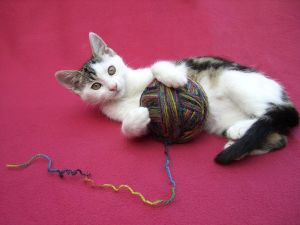Tell Tufts-Cummings Veterinary School: Declawing is Mutilation, Stop Justifying It

Wikimedia Commons
BACKGROUND
The December issue of the Tufts-Cummings Veterinary School ‘s Catnip newsletter featured an article entitled “Curb Destructive Scratching” which includes an irresponsible sidebar section on declawing entitled “The Declawing Option: What You Should Know”, which outrageously serves to legitimize and justify cat declawing in certain circumstances.
The article describes declawing as a “relatively simple” procedure with “slight risks”. This is recklessly untrue. In fact, declawing is among the most agonizing procedures a cat can undergo, and can lead to chronic pain and disability, says veterinarian Jennifer Conrad, DVM. While called “declawing”, the procedure actually involves amputating a portion of a cat’s toes, with life-long adverse affects common.
An important point Friends of Animals has long made to our members is that adopting a cat or dog means taking responsibility for their well being. Declawing—an act of cruelty which should be illegal—means renouncing the responsibility one has assumed when one adopts a cat into one’s home. We’re so serious about our anti-declawing position that we mandate that our low-cost spay neuter certificates cannot be used in the cat owner also intends on declawing their cat. Our educational pamphlet “Paws Come With Claws: That’s One of Nature’s Laws”, details the various ways that pet owners can protect themselves and their furniture without ever harming their cat.
According to Catnip’s editor-in-chief, Tufts-Cummings veterinary surgeon Dr. John Berg, “We do not do declawing procedures at Tufts-Cummings, and would consider it only if one of the very rare instances outlined in the sidebar ever arose.” Friends of Animals’ New York office contacted Dr. Berg and voiced our opposition to the contradictory message about declawing posed in Catnip’s article, yet Dr. Berg insisted that the sidebar was appropriate and even stated that he himself could “imagine circumstances in which I personally would consider performing declawing.”
Such a confused and backwards position should not be championed by a well-regarded Veterinary School.
Incredibly, the article also suggests that front-paw declawing does not render outdoor cats defenseless because they can climb “small-diameter trees”. What about cats with only wide-diameter trees available, or no trees available? How would a declawed cat escape or defend themselves from a predator then? They would be incapable of doing so.
What are the instances outlined as reasons to amputate a portion of a cat’s toes so it can’t scratch? If an owner “appears likely to euthanize or abandon the cat unless (it) undergoes the procedure” or if the cat shares a household with someone who is medically compromised.
That is a flimsy justification, and utterly without merit. Many people doing rescue and shelter work know: Declawed cats are abandoned and euthanized just like any other cat.
Although Dr. Berg says he “cannot remember the last time” a declawing was performed at Tufts-Cummings since he started as a faculty member in 1987, Catnip‘s promoting declawing as a procedure of so-called last resort justifies this cruelty.
And justifying declawing gives vets and uninformed or selfish pet owners the green light to continue mutilating cats for the crime of being cats and doing what comes naturally to them.
WHOM TO CONTACT
Email: john.berg@tufts.edu
SAMPLE LETTER
Dear Dr. Berg,
Catnip‘s careless treatment of declawing does a disservice to cats and does not reflect well on Tufts-Cummings.
Please publish an article in Catnip that takes a humane stand–with reasons declawing should never be done as behavioral intervention. If Tufts-Cummings indeed prohibits this unnecessary surgery, it is especially necessary for its newsletter to inform its readers why it takes this ethical stand.
Anyone adopting a cat must accept that scratching is a normal characteristic of a healthy cat. Amputating a portion of a cat’s toes, or severing the tendons (tendonectomy), to deal with this behavior is patently cruel. There are many humane, sensible options, such as behavioral modification techniques with rehoming, a kinder “last resort”.
Additionally, bite wounds are as dangerous as scratches. What then? Remove the cat’s teeth? To suggest that a cat should be declawed if an owner is medically compromised is absurd. It is important to also note that once deprived of claws, a cat may turn to his only other form of defense—his teeth. It is fairly common for a declawed cat to become a biter, doing so out of fear and frustration.
Furthermore, declawing does not ensure cats a secure home. People who select, care for, and train companion animals responsibly; who have realistic expectations of a cat’s innate behavior; and who make a lifetime commitment to their pets are the only things that ensure a cat a secure home.
Thank you for taking the time to read this important appeal to publish an article detailing the dangers and inhumane properties of declawing.
NAME
my paws hurt so much,
they do not feel the same,
i cannot grasp, i am not
in the cat game.
walking feels funny,
jumping so hard.
what happened to me,
why was i dealt this
cruel card?
signed,
every declawed cat!
Karen Lyons Kalmenson













































UNBELIEVABLE ! DISGUSTING ! DISGRACEFUL ! DISTURBED INHUMANE HUMANS TO EVEN THINK OF SUCH A THING !!!!!
LikeLike
I agree! Thanks, Linda.
LikeLike
Declawing is the equivalent of chopping off one’s fingertips along with the nail. If this is an unacceptable thing to do to humans, why should it be allowed for cats when it is clearly MUTILATION? This also takes away the cat’s ability to defend itself, affects its balance, personality, well being and sociability. Because there are so many alternatives, this is wrong on many levels. If it is done at all, it would have to be the last resort before euthanizing a truly dangerous psycho kitty, the lesser of two evils..
LikeLike
Thanks for your comments, Cat.
LikeLike
email sent and shared in several places thanks Stacey i am so against declawing of cats it makes me as mad as when they clip birds wings its wrong cruel and inhumane
LikeLike
I agree, thanks, hon.
LikeLike
my paws hurts so much,
they do not feel the same,
i cannot grasp, i am not
in the cat game.
walking feels funny,
jumping so hard.
what happened to me,
why was i dealt this
cruel card?
signed,
every declawed cat!
LikeLike
And so if ONE of your defence mechanisms was forcibly withdrawn, YOU’D be totally at ease with that would you??? This insane activity needs to be stopped. Surely there are other things this Vetinary outfit could and should be teaching students. How about de-sexing humanely for one. I am disgusted at these Ethic,, mind you, can’t complain about them having ANY AT ALL, cause they don’t !!!
LikeLike
Thank you, Jacqui, I agree.
LikeLike
cruel, unnatural and unnecessary. Stop this now.
LikeLike
I agree, thank you, Tina.
LikeLike
I have been reading Tufts U. School of Vet Med. cat newsletter, Catnip, for many years. I have learned a lot and I respect what you do. However, I was saddened when I saw that you promoted declawing cats as a possible way to handle destructive scratching. I have owned many cats and foster cats/kittens for the local humane society and done so for over 25 years. Early on (back in the 1980’s I did not know how awful and inhumane this procedure was and we front declawed our first two kittens. Looking back I feel horrible about having done that. In about the last 6 years, I have learned more and more about how cruel this is and what devastating effects it can have for the cat. I currently work and volunteer for a local humane society and see cat after cat turned in because they have been declawed and stop using the litter box or have become aggressive. We have stopped taking these cats in because all we can do is euthanize them and we refuse to do this anymore. We spend hours trying to educate people who want to adopt our cats/kittens about the cruelty of this practice. Many seem to listen to us. Others have their minds set. There are many options to deaing with claws and there should be laws against this hedious procedure. California is becoming a leader in outlawing declawing in some of its counties and has recently passed a bill prohibiting landlords from requiring their tenants to declaw their cats. I personally have changed the minds of a few landlords about requiring tenants to declaw cats adopted from our shelter. I could go on for paragraphs reguarding this issue. I would really appreciate seeing an article in your Catnip newsletter on the devastating effects of declawing and the humane ways of dealing with claws.
Sincerely,
Kathy Weber
LikeLike
Exceptional commentary and personal experience, Kathy. I hope you also emailed it to john.berg@tufts.edu. It used to be considered a routine procedure, I am so glad people, such as yourself, have been reeducated as to the cruelty involved. Thank you.
LikeLike
HAVE MAILED JOHN.BERG
LikeLike
Thank you, hon!
LikeLike